
by Cassandra Willyard Thursday, January 5, 2012
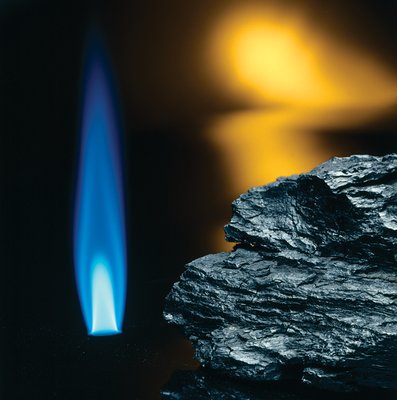
Basin Electric
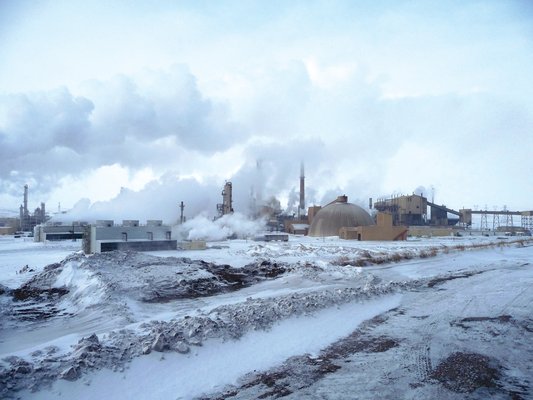
Great Plains Synfuels Plant in Beulah, N.D. Cassandra Willyard
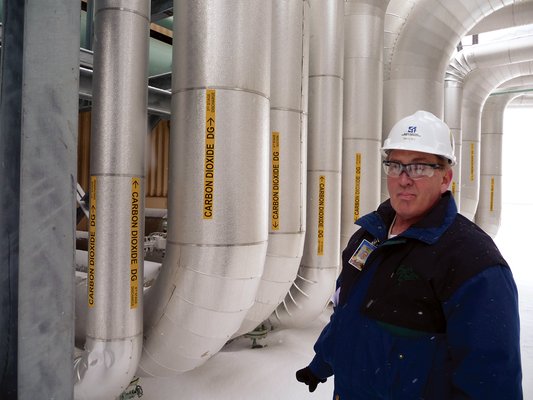
Daryl Hill, who does media relations for the Great Plains Synfuels Plant, stands outside its compressor building. Cassandra Willyard
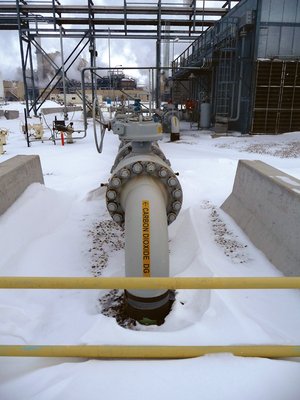
The compressor at the Great Plains Synfuels Plant carries compressed carbon dioxide from North Dakota to the oilfields of Saskatchewan. Cassandra Willyard
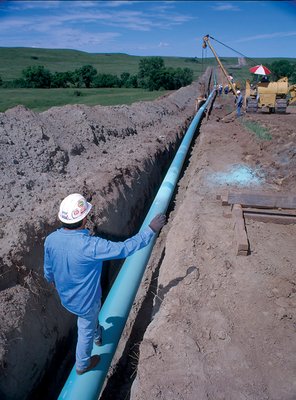
The 320-kilometer-long pipeline that carries carbon dioxide from North Dakota to Canada was constructed in 2000. Basin Electric
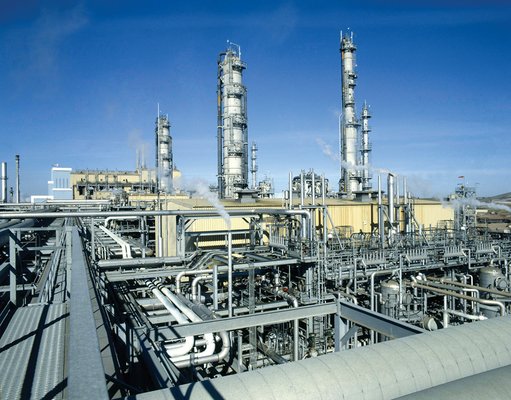
The Great Plains Synfuels Plant is the only commercial-scale coal gasification plant in the U.S. that manufactures natural gas from coal. Basin Electric
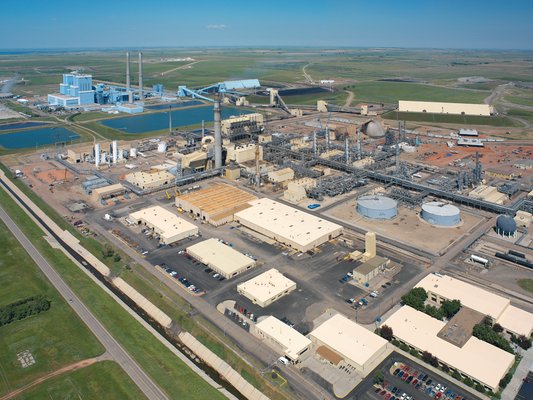
The Great Plains Synfuels plant is in the foreground; the blue structure in the background is Antelope Valley Station, a 900-megawatt power plant. Basin Electric
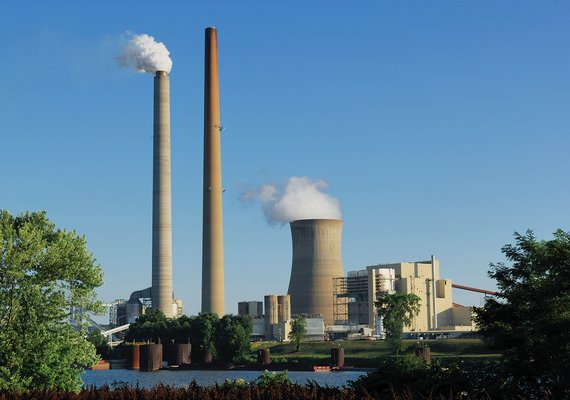
Mountaineer Plant, a 1,300-megawatt power plant in West Virginia, will begin capturing carbon dioxide in September. The CO2 will be compressed and injected into a saline aquifer beneath the plant. American Electric Power
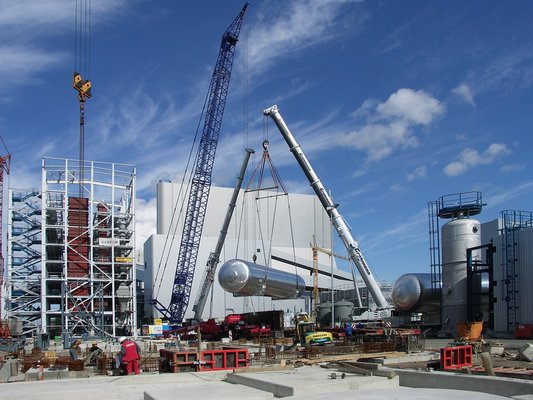
A carbon dioxide storage tank is lifted into final position during construction of the Schwarze Pumpe Pilot Plant, one of the world's first oxy-fuel plants. Vattenfall
On a remote patch of rolling plain in western North Dakota lies a massive labyrinth of buildings, tanks, towers, pipes and conveyors. This industrial behemoth — the Great Plains Synfuels Plant — is designed to turn the vast deposits of lignite coal that lie in the ground into substitute natural gas.
It is a blisteringly cold December morning, and the plant is nearly obscured by a thick blanket of steam. Still, Daryl Hill, a middle-aged Midwesterner dressed in jeans, low hikers and a burgundy pullover, is chipper. He doesn’t complain about the cold and snow, or the hour-long drive he took through some of the bleakest countryside imaginable for this meeting. Hill has done media relations for Basin Electric, the cooperative that owns the synfuels plant, for 30 years. “It’s been just a heck of an education for this old farm boy,” he says.
The Great Plains Synfuels Plant was conceived in the early 1970s, when the United States was in the midst of an energy crisis marked by oil embargoes, skyrocketing energy prices and rumors of dwindling natural gas supplies. As the country scrambled to develop new sources of homegrown energy, some people touted solar power. Others touted wind. A small group of gasmen from Detroit, however, envisioned an entirely different solution — a fleet of “gasification” plants that would turn the country’s vast supplies of coal into substitute natural gas, or syngas. But by 1984, when the Great Plains plant opened for business, the national energy crisis had passed. The other plants were never built. Today Great Plains is still the only commercial plant in the country that turns coal into gas.
To demonstrate how the plant works, Hill uses a scale model. The model, which fills an entire room, served as a 3-D blueprint when the plant was built. Now, however, it is a teaching tool — one of the highlights of his tour. “Here is the heart of the plant,” Hill says, pointing out the building that holds the 14 large chambers — called gasifiers — where lignite, a soft form of coal, is combined with scalding steam and oxygen to create a fuel called “syngas.” After some of the impurities are removed, the syngas — mostly hydrogen and carbon monoxide — travels to the next station, where it is chemically transformed into the methane that makes up synthetic natural gas. “This is a chemist’s dream,” Hill says. “We are literally breaking apart the chemistry of lignite.”
The model is excruciatingly detailed, down to the last tube, but it does not show the latest additions to the synfuels plant. One of the byproducts of turning coal into natural gas is carbon dioxide. Previously, the plant vented the carbon dioxide into the atmosphere, but in 2000, the company began capturing the gas, compressing it and piping it 320 kilometers north to the Weyburn oilfield in Saskatchewan. There the carbon dioxide is injected into the ground, where it becomes permanently trapped. The process is called carbon capture and storage.
For Basin Electric, adding carbon capture to the synfuels plant made good economic sense. Pumping carbon dioxide into oil reservoirs helps bring oil to the surface, so Canadian oil companies pay Basin Electric for its carbon dioxide. (Hill won’t say how much.) Given the volatility of natural gas prices, any byproduct of the gasification process that can be sold helps the Great Plains plant stay profitable, even in lean times.
But many see carbon capture and storage in a different light — as a much-needed technological solution to climate change. Coal is abundant and cheap, but when burned it releases more carbon dioxide than any other fossil fuel, twice as much as natural gas. Yet experts predict that in the near future, at least, the world will use more coal, not less, to meet the growing demand for electricity. But if coal-fired power plants could capture their carbon dioxide emissions and permanently store them underground — as the Great Plains Synfuels Plant does — they could drastically reduce their impact on the global climate.
Today, the synfuels plant is part of the largest carbon capture and storage project in the world. Every year Great Plains sends 1.5 million tons of carbon dioxide — two-thirds of what the plant produces — to Canada to be permanently sequestered. Over the past eight years, 13 million tons have been stored. And that has made Hill’s tour immensely popular (even “60 Minutes” has stopped by). Still, as massive as the effort is, the amount of carbon being captured is only a tiny fraction of what is produced. The United States has more than 500 coal-fired power plants, which produce 50 percent of the country’s electricity and churn out 2 billion tons of carbon dioxide each year, about 30 percent of the country’s total yearly carbon emissions. Worldwide there are tens of thousands of coal-fired power plants. Together these plants produce approximately 45 percent of the world’s electricity and churn out more than 11 billion tons of carbon dioxide each year, about 40 percent of global annual emissions. To make a real impact on annual carbon dioxide emissions, experts say, the technology needs to be added to all coal-fired power plants — not just a single synfuels plant.
One of the biggest hurdles to realizing this goal, however, is the cost. This is going to cost real money, says Howard Herzog, an engineer at MIT’s Laboratory for Energy and the Environment in Cambridge, Mass. Constructing a state-of-the-art coal-fired power plant designed to efficiently capture carbon dioxide costs at least a billion dollars. Retrofitting existing plants with carbon capture technology is less expensive initially, but it significantly reduces the plant’s efficiency, making the equipment prohibitively expensive to operate in the long run. “The only way that it’s going to be worthwhile for the companies to do it,” Herzog says, “is if they get charged for putting carbon dioxide in the atmosphere.”
The United States has not yet started regulating carbon emissions. Still, American Electric Power, one of the largest utilities in the country, is betting that will happen. “We believe that [the United States is] headed down a path where carbon emissions are going to have a cost associated with them,” says Mark Gray, AEP’s vice president of Engineering Services. That is why the company has decided to retrofit one of its largest power plants with carbon capture technology.
AEP’s 1,300-megawatt Mountaineer Plant is located in New Haven, W.Va., at the eastern end of the Ohio River Valley, a swath of land from Illinois to Virginia. The valley is home to nearly 50 coal-fired power plants that produce 20 percent of the nation’s coal-fired electricity. As a result, America’s “electric breadbasket” is also a large contributor of carbon dioxide, pumping out some 800 million tons each year.
The Mountaineer Plant, like almost all existing coal-fired power plants, produces electricity by burning pulverized coal. The heat from combustion converts water into steam, and the steam turns a turbine, which generates electricity. The gases left after combustion — mainly carbon dioxide and nitrogen — escape into the atmosphere through a towering smokestack. This plant generates 6 million tons of carbon dioxide each year.
AEP decided to start capturing and storing carbon dioxide in 2007. The company has spent the past couple of years equipping the Mountaineer Plant with technology that can separate carbon dioxide from the hot flue gas that comes out of the smokestack. Retrofitting coal-fired power plants is not a novel idea. Over the past two decades, most coal-fired power plants have been fitted with “scrubbers” that strip the flue gas of sulfur dioxide, nitrogen oxides and particulates. But the technology that exists to siphon off carbon dioxide is slightly more complicated.
To store carbon dioxide, a power plant must first separate it from the other gases that exit through the smokestack. Today, carbon dioxide is typically captured using chemicals called amines. The power plant’s flue gas enters an absorber where amines bind with the carbon dioxide. Then the amines, now loaded with carbon dioxide, travel to a “stripper.” When heated, the chemicals release the carbon dioxide, which is dried, compressed and pumped underground. The amines, now free of carbon dioxide, are recycled.
The process works well, but it is energy intensive. “Amines are very good at capturing the carbon dioxide, but they don’t want to let go,” Gray says. To produce the intense heat the amines need to release the carbon dioxide requires a monstrous amount of energy, which makes the system expensive to operate. Furthermore, the energy that goes to capturing carbon can’t be used to heat homes, run blow dryers or power laptops, which means that more coal must be burned and more emissions captured.
Today’s capture research is focused on finding a “magic elixir,” Gray says, that will separate the carbon dioxide from the plant’s other waste gases and, more importantly, release it without consuming too much energy. AEP has decided to go with a system that uses chilled ammonia to absorb the carbon dioxide. It’s not yet a magic elixir, but it should be more efficient than an amine-based system. Carbon capture using amines can consume as much as 30 percent of a plant’s power output. But AEP hopes that using chilled ammonia will cut the power use in half.
The chilled ammonia technology has already been installed at the Pleasant Prairie Power Plant, a standard coal-fired power plant in southeastern Wisconsin, where it has been successfully capturing carbon dioxide for more than a year. After the carbon is captured, however, it is vented back into the atmosphere. There are not any storage sites nearby. And the pilot project was designed simply to show that the capture technology works. AEP will go a step further, compressing and injecting the carbon dioxide into a deep saline aquifer below the Ohio River Valley.
AEP plans to begin capturing carbon dioxide in September. The company’s goal is not to significantly cut the plant’s carbon dioxide emissions — not yet, anyway — but rather to test the viability of the technology. Mountaineer will capture about 100,000 tons of carbon dioxide a year — far more than Pleasant Prairie, but less than 2 percent of Mountaineer’s total emissions. You have to crawl, Gray says, before you can walk.
Sarah Forbes is a 30-something firecracker with short brown hair and an infectious smile. A biologist who started out with DOE’s National Energy Technology Laboratory, Forbes has been working on carbon capture and storage nearly her whole career. Today she serves as a carbon capture and storage guru at the World Resources Institute, an environmental think tank in Washington, D.C.
Forbes says that carbon capture and storage technology has entered the “valley of death.” All of the pieces exist, she says, “but we haven’t done them at scale and we haven’t done them all together.” And unless that happens, she says, the technology will never be deployed.
The next step is to build demonstration plants that can capture and inject at least a million tons of carbon dioxide a year. That is less than what the synfuels plant captures and far less than what a standard coal-fired power plant emits, but it is a necessary intermediary step between pilot projects and full commercial rollout. At a meeting of environmental journalists last year, Forbes argued that large-scale demonstration projects are the only way to accurately estimate what carbon capture and storage will cost. Current estimates “are based on paper studies,” she said. “There’s great uncertainty.”
Demonstration projects have long been discussed, but the first one has yet to be built. “That’s really the next big step,” Herzog says. In 2008, the G8 nations announced the hope of having 20 demonstration projects operational by 2020. But not all the projects are progressing as rapidly as scientists might wish, and Herzog is skeptical that we will see that many. Still, dozens are in the works.
In 2003, the Bush administration announced plans to build the country’s first demonstration plant. FutureGen, a 275-megawatt coal-fired power plant, was slated to be a state-of-the-art integrated gasification combined-cycle coal plant, otherwise known as IGCC. A standard coal-fired power plant burns the coal, using the heat to convert water to steam to turn a turbine. In an IGCC plant, however, the coal is turned into syngas using a process much like the one the Great Plains Synfuels Plant uses. This gas is combusted, spinning a gas turbine like the ones used to generate electricity in natural gas power plants. The excess heat goes to generate steam, which spins a second turbine, maximizing the plant’s efficiency. IGCC plants are not only more efficient than traditional coal-fired power plants, they also make carbon capture less costly because the carbon dioxide can be siphoned off before combustion — a less energy-intensive process.
The downside of IGCC plants is that they are expensive to build. Construction on FutureGen was set to begin this year. But last year, DOE pulled the plug when the plant’s price tag ballooned from $1 billion to $1.87 billion. The department decided to use its money instead to help private investors add carbon capture and storage technology to already planned commercial IGCC plants.
Only two commercial IGCC plants have been built in the United States, both with initial funding from DOE. A third may soon be built. Duke Energy has received approval to put a 630-megawatt IGCC plant in Edwardsport, Ind. But other power companies haven’t been so lucky. AEP proposed two 600-megawatt IGCC plants in the Ohio River Valley a couple of years ago. Because IGCC plants are so expensive, however, the company wanted permission to raise electricity rates to recover its costs. Virginia rejected AEP’s proposal. Ohio gave AEP permission to raise rates, but industrial customers and consumer advocates challenged the decision. So for now, the proposal is stalled.
Another option for efficient carbon capture is a technology called oxy-fuel combustion. Oxy-fuel plants use pulverized coal like traditional plants, but they combust it in a mixture of pure oxygen and recycled flue gas (instead of ambient air). The end result is still electricity. But rather than generating a complex mix of gases, oxy-fuel plants emit mainly carbon dioxide and water. Flue gas from standard coal-fired power plants is about 15 percent carbon dioxide. But oxy-fuel plant emissions can theoretically be 95 percent carbon dioxide. That means that the carbon dioxide could be dried, compressed and piped straight into the ground without going through a costly separation process. Klaus Lackner, a geophysicist at Columbia University’s Earth Engineering Center in New York, says oxy-fuel plants could be built without smokestacks, making them true “zero-emissions” plants.
One of the first oxy-fuel plants began operating last fall in Schwarze Pumpe, Germany. This month, the plant will begin capturing carbon dioxide — about 100,000 tons a year — compressing it, and trucking it to a nearby gas field, where it will be injected for enhanced gas recovery. If all goes according to plan, Schwarze Pumpe will become the first power plant to marry carbon capture and storage. Although the plant is only 30 megawatts — too small to be considered a true demonstration project — a larger 250-megawatt demonstration plant is planned for 2015.
Other demonstration projects are in the works too. China has GreenGen, a 250-megawatt plant slated to be operational in 2010 that uses a combination of IGCC technology and fuel cells. Australia has ZeroGen, an 80-megawatt IGCC plant with a tentative startup date of 2012.
But if these projects are delayed or scrapped like FutureGen, the first demonstration projects may well be retrofits. AEP recently applied for DOE funding to turn the Mountaineer Plant into a full-scale demonstration project. And Basin Electric plans to equip its coal-fired 900-megawatt Antelope Valley plant, located just a stone’s throw from the Great Plains Synfuels Plant, with technology capable of capturing a million tons of carbon dioxide a year. The carbon dioxide could then be piped to Canada, or used in North Dakota’s oilfields. On Jan. 15, then-Secretary of Agriculture Ed Schafer announced that the U.S. Department of Agriculture would loan Basin Electric $300 million for the project. Antelope Valley could begin capturing carbon as soon as 2012.
To move into commercial rollout, Herzog says, we need to see at least five demonstration plants come online. But there are no guarantees. “Each of these demonstrations is pretty expensive,” he says. “They can be a billion dollars.” With the state of the global economy, he says, “the question is, ‘Will there be money?’”
Every two years, the carbon capture and storage community meets at the Greenhouse Gas Control Technologies conference. The 2006 conference, held in Trondheim, Norway, attracted 950 attendees. Last year’s conference in November brought 1,500 delegates to Washington, D.C. “There was a feeling at the meeting that people are ready to move ahead,” Herzog says. “What’s slowing this down is economics. Someone has to write the check.”
In the United States, the new administration may be willing to do just that. President Barack Obama has been outspoken about clean energy. And when EARTH went to press, the latest version of the stimulus package contained $2.4 billion for carbon capture and demonstration projects. Obama has even talked about reviving FutureGen.
Other politicians, however, aren’t so keen on keeping coal in the mix. Senate Majority Leader Harry Reid, D-Nev., for instance, has vehemently opposed new coal-fired power plants in Nevada. At a clean energy summit in Reno in 2007, Reid said that if utility companies need a “bridge” between old technologies and clean energy — wind, solar and geothermal — they should construct natural gas plants rather than those fueled by coal. A spokesperson for Reid, however, says the senator does support federal carbon capture and storage research and development.
“The slow part of the process is the political side,” says Lackner of Columbia University. “You really can’t do it without the buy-in of the public. Part of it is outreach — convincing people that this is indeed serious.”
That may be more difficult than it seems. Some environmentalists fear that the technology will encourage the power industry to use more coal. And others worry about the carbon dioxide reservoirs leaking. Indeed, if carbon capture and storage proves to be a success, it could mean storing billions upon billions of tons of carbon dioxide underground. At least one person told World Resources Institute’s Forbes that the idea sounds “spooky.” Even Forbes used to be concerned: “Would that carbon dioxide just burp back out of the earth, and would all that effort that we’d undergone be for nothing?”
Many geologists are convinced that if the injection sites are carefully selected, the carbon dioxide will stay put. But the sites do need to be monitored and regulated. Other issues have yet to be resolved as well. No one has quite worked out a model for who would be liable should an accident occur decades down the road. And officials in many parts of the United States have yet to determine who owns the pore space that would be used for storage. Wyoming has ruled that underground pore space belongs to whoever owns the surface. If other states follow suit, that could make siting carbon storage reservoirs difficult if surface owners are uncooperative.
Still, Forbes is optimistic that all of these obstacles can be overcome. One thing is certain, she says, “You can’t solve the climate change problem without a solution for coal.” And for now, she says, carbon capture and storage is the only solution that exists.
© 2008-2021. All rights reserved. Any copying, redistribution or retransmission of any of the contents of this service without the expressed written permission of the American Geosciences Institute is expressly prohibited. Click here for all copyright requests.